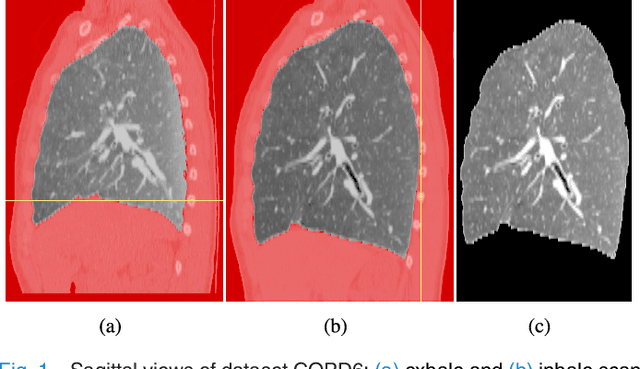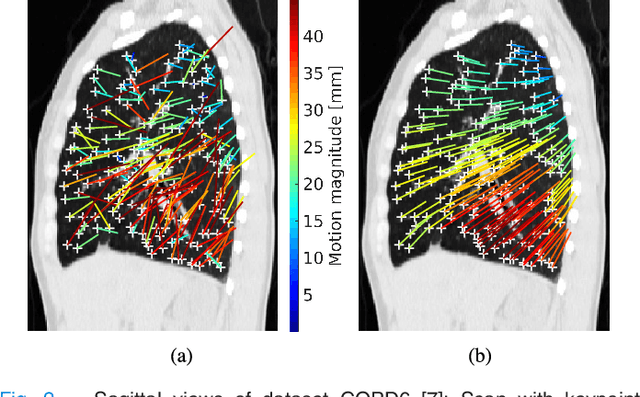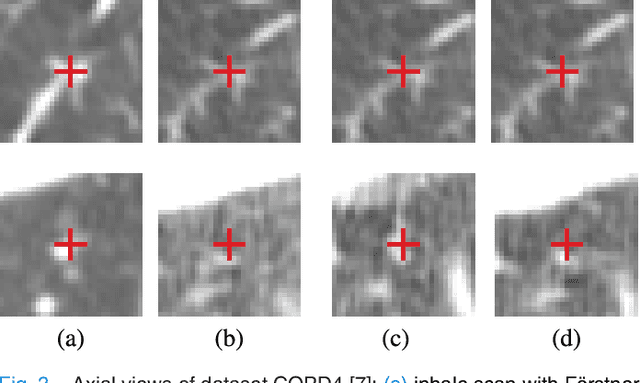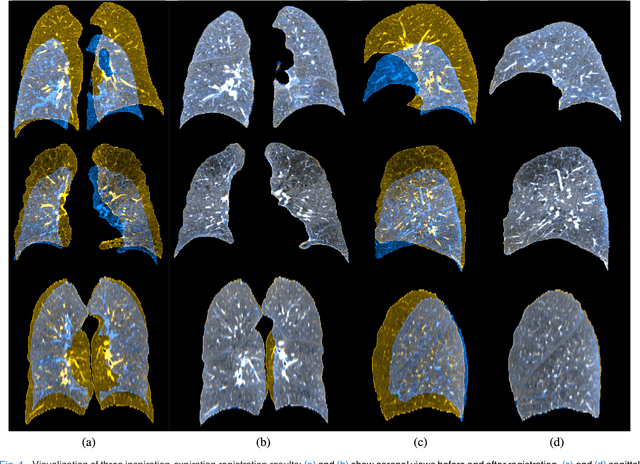Jan Rühaak
Estimation of Large Motion in Lung CT by Integrating Regularized Keypoint Correspondences into Dense Deformable Registration
Jul 02, 2018



Abstract:We present a novel algorithm for the registration of pulmonary CT scans. Our method is designed for large respiratory motion by integrating sparse keypoint correspondences into a dense continuous optimization framework. The detection of keypoint correspondences enables robustness against large deformations by jointly optimizing over a large number of potential discrete displacements, whereas the dense continuous registration achieves subvoxel alignment with smooth transformations. Both steps are driven by the same normalized gradient fields data term. We employ curvature regularization and a volume change control mechanism to prevent foldings of the deformation grid and restrict the determinant of the Jacobian to physiologically meaningful values. Keypoint correspondences are integrated into the dense registration by a quadratic penalty with adaptively determined weight. Using a parallel matrix-free derivative calculation scheme, a runtime of about 5 min was realized on a standard PC. The proposed algorithm ranks first in the EMPIRE10 challenge on pulmonary image registration. Moreover, it achieves an average landmark distance of 0.82 mm on the DIR-Lab COPD database, thereby improving upon the state of the art in accuracy by 15%. Our algorithm is the first to reach the inter-observer variability in landmark annotation on this dataset.
* 12 pages, 7 figures, \c{opyright} 2017 IEEE. Personal use is permitted, but republication/redistribution requires IEEE permission
A matrix-free approach to parallel and memory-efficient deformable image registration
Apr 27, 2018



Abstract:We present a novel computational approach to fast and memory-efficient deformable image registration. In the variational registration model, the computation of the objective function derivatives is the computationally most expensive operation, both in terms of runtime and memory requirements. In order to target this bottleneck, we analyze the matrix structure of gradient and Hessian computations for the case of the normalized gradient fields distance measure and curvature regularization. Based on this analysis, we derive equivalent matrix-free closed-form expressions for derivative computations, eliminating the need for storing intermediate results and the costs of sparse matrix arithmetic. This has further benefits: (1) matrix computations can be fully parallelized, (2) memory complexity for derivative computation is reduced from linear to constant, and (3) overall computation times are substantially reduced. In comparison with an optimized matrix-based reference implementation, the CPU implementation achieves speedup factors between 3.1 and 9.7, and we are able to handle substantially higher resolutions. Using a GPU implementation, we achieve an additional speedup factor of up to 9.2. Furthermore, we evaluated the approach on real-world medical datasets. On ten publicly available lung CT images from the DIR-Lab 4DCT dataset, we achieve the best mean landmark error of 0.93 mm compared to other submissions on the DIR-Lab website, with an average runtime of only 9.23 s. Complete non-rigid registration of full-size 3D thorax-abdomen CT volumes from oncological follow-up is achieved in 12.6 s. The experimental results show that the proposed matrix-free algorithm enables the use of variational registration models also in applications which were previously impractical due to memory or runtime restrictions.
 Add to Chrome
Add to Chrome Add to Firefox
Add to Firefox Add to Edge
Add to Edge